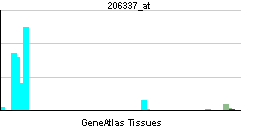C-C chemokine receptor type 7
| Chemokine (C-C motif) receptor 7 | |||||||||||
|---|---|---|---|---|---|---|---|---|---|---|---|
| Identifiers | |||||||||||
| Symbols | CCR7 ; BLR2; CD197; CDw197; CMKBR7; EBI1 | ||||||||||
| External IDs | Template:OMIM5 Template:MGI HomoloGene: 1387 | ||||||||||
| |||||||||||
| RNA expression pattern | |||||||||||
 | |||||||||||
| More reference expression data | |||||||||||
| Orthologs | |||||||||||
| Template:GNF Ortholog box | |||||||||||
| Species | Human | Mouse | |||||||||
| Entrez | n/a | n/a | |||||||||
| Ensembl | n/a | n/a | |||||||||
| UniProt | n/a | n/a | |||||||||
| RefSeq (mRNA) | n/a | n/a | |||||||||
| RefSeq (protein) | n/a | n/a | |||||||||
| Location (UCSC) | n/a | n/a | |||||||||
| PubMed search | n/a | n/a | |||||||||
Chemokine (C-C motif) receptor 7, also known as CCR7, is a human gene.
CCR7 has also recently been designated CD197 (cluster of differentiation 197).
The protein encoded by this gene is a member of the G protein-coupled receptor family. This receptor was identified as a gene induced by the Epstein-Barr virus (EBV), and is thought to be a mediator of EBV effects on B lymphocytes. This receptor is expressed in various lymphoid tissues and activates B and T lymphocytes. It has been shown to control the migration of memory T cells to inflamed tissues, as well as stimulate dendritic cell maturation. The chemokine (C-C motif) ligand 19 (CCL19/ECL) has been reported to be a specific ligand of this receptor.[1]
References
Further reading
- Müller G, Lipp M (2003). "Shaping up adaptive immunity: the impact of CCR7 and CXCR5 on lymphocyte trafficking". Microcirculation (New York, N.Y. : 1994). 10 (3–4): 325–34. doi:10.1038/sj.mn.7800197. PMID 12851649.
- Burgstahler R, Kempkes B, Steube K, Lipp M (1995). "Expression of the chemokine receptor BLR2/EBI1 is specifically transactivated by Epstein-Barr virus nuclear antigen 2". Biochem. Biophys. Res. Commun. 215 (2): 737–43. doi:10.1006/bbrc.1995.2525. PMID 7488016.
- Schweickart VL, Raport CJ, Godiska R; et al. (1995). "Cloning of human and mouse EBI1, a lymphoid-specific G-protein-coupled receptor encoded on human chromosome 17q12-q21.2". Genomics. 23 (3): 643–50. doi:10.1006/geno.1994.1553. PMID 7851893.
- Birkenbach M, Josefsen K, Yalamanchili R; et al. (1993). "Epstein-Barr virus-induced genes: first lymphocyte-specific G protein-coupled peptide receptors". J. Virol. 67 (4): 2209–20. PMID 8383238.
- Bonaldo MF, Lennon G, Soares MB (1997). "Normalization and subtraction: two approaches to facilitate gene discovery". Genome Res. 6 (9): 791–806. PMID 8889548.
- Yoshida R, Imai T, Hieshima K; et al. (1997). "Molecular cloning of a novel human CC chemokine EBI1-ligand chemokine that is a specific functional ligand for EBI1, CCR7". J. Biol. Chem. 272 (21): 13803–9. PMID 9153236.
- Yoshida R, Nagira M, Kitaura M; et al. (1998). "Secondary lymphoid-tissue chemokine is a functional ligand for the CC chemokine receptor CCR7". J. Biol. Chem. 273 (12): 7118–22. PMID 9507024.
- Campbell JJ, Bowman EP, Murphy K; et al. (1998). "6-C-kine (SLC), a lymphocyte adhesion-triggering chemokine expressed by high endothelium, is an agonist for the MIP-3beta receptor CCR7". J. Cell Biol. 141 (4): 1053–9. PMID 9585422.
- Kim CH, Pelus LM, White JR, Broxmeyer HE (1998). "Macrophage-inflammatory protein-3 beta/EBI1-ligand chemokine/CK beta-11, a CC chemokine, is a chemoattractant with a specificity for macrophage progenitors among myeloid progenitor cells". J. Immunol. 161 (5): 2580–5. PMID 9725259.
- Yanagihara S, Komura E, Nagafune J; et al. (1998). "EBI1/CCR7 is a new member of dendritic cell chemokine receptor that is up-regulated upon maturation". J. Immunol. 161 (6): 3096–102. PMID 9743376.
- Hasegawa H, Nomura T, Kohno M; et al. (2000). "Increased chemokine receptor CCR7/EBI1 expression enhances the infiltration of lymphoid organs by adult T-cell leukemia cells". Blood. 95 (1): 30–8. PMID 10607681.
- Gosling J, Dairaghi DJ, Wang Y; et al. (2000). "Cutting edge: identification of a novel chemokine receptor that binds dendritic cell- and T cell-active chemokines including ELC, SLC, and TECK". J. Immunol. 164 (6): 2851–6. PMID 10706668.
- Agace WW, Roberts AI, Wu L; et al. (2000). "Human intestinal lamina propria and intraepithelial lymphocytes express receptors specific for chemokines induced by inflammation". Eur. J. Immunol. 30 (3): 819–26. doi:10.1002/1521-4141(200003)30:3<819::AID-IMMU819>3.0.CO;2-Y. PMID 10741397.
- Annunziato F, Romagnani P, Cosmi L; et al. (2000). "Macrophage-derived chemokine and EBI1-ligand chemokine attract human thymocytes in different stage of development and are produced by distinct subsets of medullary epithelial cells: possible implications for negative selection". J. Immunol. 165 (1): 238–46. PMID 10861057.
- Campbell JJ, Murphy KE, Kunkel EJ; et al. (2001). "CCR7 expression and memory T cell diversity in humans". J. Immunol. 166 (2): 877–84. PMID 11145663.
- Campbell JJ, Qin S, Unutmaz D; et al. (2001). "Unique subpopulations of CD56+ NK and NK-T peripheral blood lymphocytes identified by chemokine receptor expression repertoire". J. Immunol. 166 (11): 6477–82. PMID 11359797.
- Taylor JR, Kimbrell KC, Scoggins R; et al. (2001). "Expression and function of chemokine receptors on human thymocytes: implications for infection by human immunodeficiency virus type 1". J. Virol. 75 (18): 8752–60. PMID 11507220.
- Höpken UE, Foss HD, Meyer D; et al. (2002). "Up-regulation of the chemokine receptor CCR7 in classical but not in lymphocyte-predominant Hodgkin disease correlates with distinct dissemination of neoplastic cells in lymphoid organs". Blood. 99 (4): 1109–16. PMID 11830455.
- Nakayama T, Fujisawa R, Izawa D; et al. (2002). "Human B cells immortalized with Epstein-Barr virus upregulate CCR6 and CCR10 and downregulate CXCR4 and CXCR5". J. Virol. 76 (6): 3072–7. PMID 11861876.
- Till KJ, Lin K, Zuzel M, Cawley JC (2002). "The chemokine receptor CCR7 and alpha4 integrin are important for migration of chronic lymphocytic leukemia cells into lymph nodes". Blood. 99 (8): 2977–84. PMID 11929789.
This article incorporates text from the United States National Library of Medicine, which is in the public domain.
| Stub icon | This membrane protein–related article is a stub. You can help Wikipedia by expanding it. |